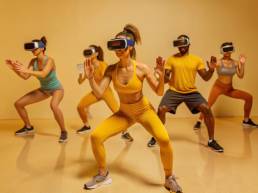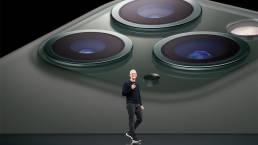Every presenter knows that great presentations are not remembered for the words written on their slides. They’re remembered for the impact the speaker and visuals leave on the audience.
Thanks to technological advancements, unconventional presentation formats are becoming more accessible. From futuristic 3D holograms to augmented reality – the limits to what we can create are expanding daily. These unconventional formats are still new and exciting to audiences. Meaning, that when designed well, early adopters will be able to leave a lasting impression.
Today, I want to explore seven presentation formats you can use to wow your audience.
Storytelling with Data Visualization
Raw data can be challenging to make engaging. The key is to turn numbers and percentages into a story your audience can follow. Plain line graphs and pie charts alone do not impress people anymore. We like a little flash and CGI. Instead, you must create a narrative that takes audiences on a climb up over a climactic hill, and back down for the final fall where they land safely at your goal. Data must be seen and heard. Renowned presenters like Tony Robbins, Steve Jobs, and Bill Gates are all master data storytellers.
You can be too. With the creation of interactive elements, updated transitions, animations, and a bit of creativity – data visualization can uplift your presentations.
Creative ways to include storytelling in your presentations:
- Interactive data visualizations
- Morphing slides (via Microsoft PowerPoint)
- Infographics
- Motion graphics
- Evolutionary charts
Whether your presentation is a pitch to potential investors or a routine all-hands meeting – use every opportunity to scratch your data storytelling abilities.

Presentations don’t have to be a one-way communication process. Interactive charts and clickable dashboards can help keep your audience interested.
Immersive Virtual Reality (VR) Presentations
VR may not be a common household tool yet, but it has crept into the world of presentations. VR presentations immerse audiences in a virtual environment. The result creates an impact that leaves audiences remembering what was said and seen. They are commonly used in real estate walkthroughs, product demos, and even high-profile archeology exhibits.
VR presentations are typically created at the hands of a professional. Some play automatically and others can be controlled to flow as you’re speaking. The key is to capture as much detail as possible in the visuals. The more realistic, the better.
VR presentations are great for:
- Architectural walkthroughs
- Educational simulations
- Product demonstrations
PechaKucha Presentations
PechaKucha presentations are concise and fast-paced. A true PechaKucha consists of exactly 20 slides timed at 20 seconds each. They’re designed primarily with imagery only slides – to keep your audience’s attention focused on your presentation. You can imagine the challenge that presents. PechaKuchas forces speakers to rely nearly entirely on their narrative and presents a precise time limit.
They’re rare in everyday business use cases and appear more often in presentations created for stages and events. That being said, as a presentation designer I enjoy the challenge of creating visual-only designs. It’s one of the presentation styles I recommend trying to those who seek to become expert speakers.
PechaKucha Presentations are best used to share:
- Personal journeys
- Project showcases
- Motivational presentations
Pecha Kucha is a presentation method that calls for telling a story using images rather than reading text. With 20 slides and only 20 seconds of commentary per slide, the total presentation should be just 6 minutes and 40 seconds.

Interactive & Gamified Learning Presentations
If it can be gamified, do it. That’s the mindset more and more educational presentations turn to. This design style encourages audience participation and engagement through interactive activities. Educational experts, like Hooked on Phonics, have turned to designing interactive presentations that allow children to touch, feel, and explore their way through learning. Other popular uses are coding workshops, quizzes, and (my favorite) escape room presentations.
Gamification brings many fun benefits to business as well. Companies are starting to adapt this style to train employees, engage target buyers, and in viral marketing campaigns. Most recently, I’ve seen an uptick in design thinking workshops to engage remote workers and replace traditional company retreats. In these workshops, managers lead participants through problem-solving exercises, encouraging collaboration and creativity.
I believe we’ll see more use of gamification in the future. Gamification presentation examples include:
- Design thinking workshops
- Cooking demonstrations
- Coding workshops
- Quiz-style presentations
- Escape room presentations
Augmented Reality (AR) Guided Tours
It may surprise you that Augmented Reality (AR) presentations are widely used today. Using AR technology, designers can overlay digital information onto the physical world, enhancing understanding and engagement. AR guided tours are popular in museum exhibits.
By creating interactive experiences for participants, businesses create more impact. I foresee AR presentations being adapted by more industries in the future. Their potential to teach or sell consumers on a concept is too powerful to pass on.
My favorite examples of AR Presentations are:
- Muséum National d’Histoire Naturelle experience using Microsoft HoloLens
- The National Museum of Singapore’s exhibit, Story of the Forest

While mostly used by museums and art galleries, nothing prevents AR from expanding to the way other businesses convey information.
Interactive 3D Holographic Displays
Remember old 90s movies set in 2010, where cars flew and computers were watches or pieces of glass that projected information into 3D images at the tap of a button? The cars may still be a dream but 3D holographic presentations are real. They have been since 2013 or earlier. Admittedly, these are my favorite unconventional presentation style and I’d love to see them used more.
Using advanced holographic technology, presenters can create three-dimensional visualizations that seemingly float in mid-air. Microsoft’s HoloLens software allows presenters to interact with holographic elements, bringing data and concepts to life in a tangible way. Magic Leap One is another early 3D presentation company that took a different approach. Their mixed reality headset enables presenters to merge digital and physical worlds, delivering immersive presentations that break the boundaries of traditional slides.
3D presentations are best saved for stages or events. Despite their flash, the same rules apply. Even holographic presentations must be carefully designed to support the concepts being presented by the speaker – not distract.
Check out this video to experience the impact of 3D holographic presentations for yourself.
- Leading 3D holographic presentation technology:
- Microsoft’s HoloLens
- Magic Leap One
Collaborative Virtual Worlds
COVID taught us a lot of things, including the power of collaboration and connection with our peers. That’s manifested in the rise of collaborative virtual worlds that utilize VR platforms to create shared spaces where presenters and attendees interact. The goal is to encourage creative brainstorming, engaging events, and active trainings.
We saw this a lot with virtual conference booth exhibits, where virtual attendees could walk around virtual booths to explore what each company had to offer. There’s also been a rise in virtual summits, where attendees interact with presenters after their sessions. Recently, I took part in a great virtual event with Remiovr. Team Class has also created popular virtual collaboration tools for teams.
Working on these VR worlds takes a keen eye for detail and an understanding of how participants will want to interact. User experience is critical. VR worlds can be challenging to construct, but are extremely fun and impactful to audiences.
Collaborative virtual worlds are great For:
- Virtual spacial meetings
- Remote team collaboration
- Online events and retreats
- Workshops and online classes
- Trade conferences
- Fitness and virtual workouts
The future of fitness classes could be virtual. The 2020 pandemic sadly brought us closer to this reality.

Don’t Be Afraid to Explore the Unconventional
The biggest rewards come from stepping outside the conventional. These examples of unconventional presentation formats are all designed to captivate audiences in unique and memorable ways. From 3D to gamification – these are the future (and present) of marketing. I encourage you to experiment and find new ways to wow your audience.
If you’d like to team up to create any of the mentioned presentation styles from this list – reach out! I am always open to collaborating on new and exciting projects.
Borja Zamora
A Barcelona native but San Francisco based, Borja explores digital marketing and design through articles, images, and quotes.
Related Posts
December 12, 2024
10 Innovative Presentation Design Trends to Watch in 2025
Explore the top ten innovative presentation design trends for 2025 that will…
December 5, 2024
How to Become a Freelance Powerpoint Designer (Part 2)
Discover essential strategies for becoming a successful freelance PowerPoint…
December 5, 2024
How to Become a Freelance Powerpoint Designer (Part 1)
Unlock the secrets to becoming a successful freelance PowerPoint designer.…
September 23, 2024
AI-Powered Storytelling in Presentations: Captivate Your Audience with AI
Craft unforgettable presentations with the power of AI-generated narratives.…
Related Posts
December 12, 2024
10 Innovative Presentation Design Trends to Watch in 2025
Explore the top ten innovative presentation design trends for 2025 that will…
December 5, 2024
How to Become a Freelance Powerpoint Designer (Part 2)
Discover essential strategies for becoming a successful freelance PowerPoint…
December 5, 2024
How to Become a Freelance Powerpoint Designer (Part 1)
Unlock the secrets to becoming a successful freelance PowerPoint designer.…
September 23, 2024
AI-Powered Storytelling in Presentations: Captivate Your Audience with AI
Craft unforgettable presentations with the power of AI-generated narratives.…






